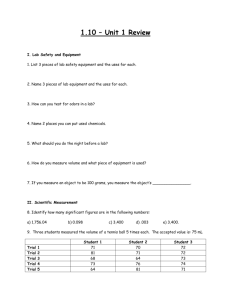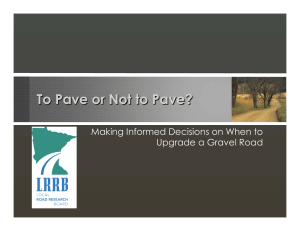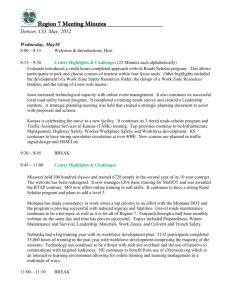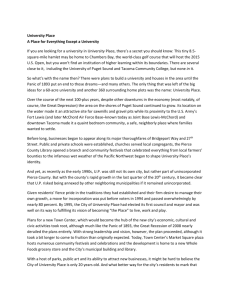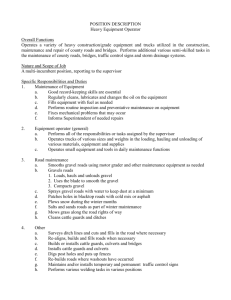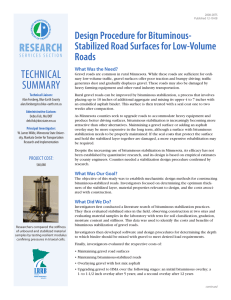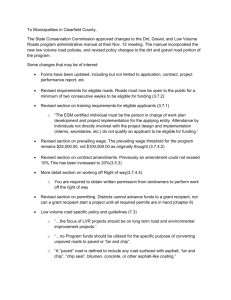Cost Comparison of Treatments Used to Maintain or Upgrade
advertisement
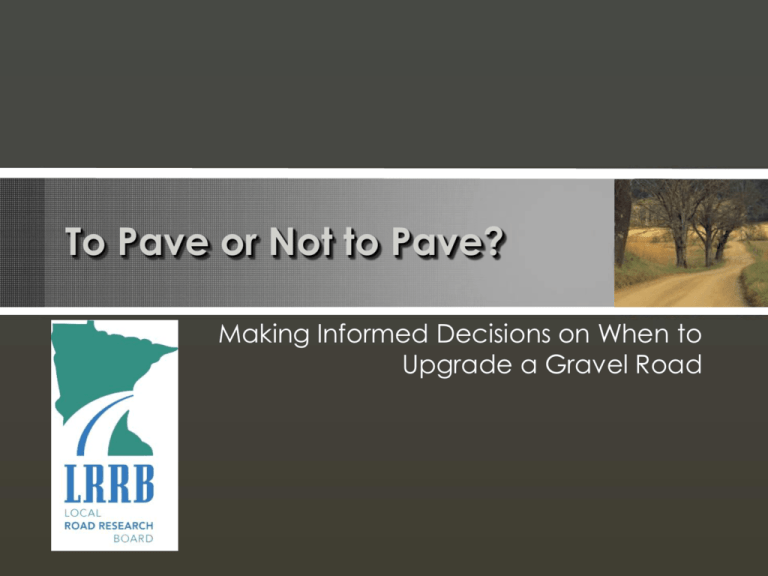
To Pave or Not to Pave? Making Informed Decisions on When to Upgrade a Gravel Road How to decide when to pave or not? • Two new reports offer some help: • Cost Comparison of Treatments Used to Maintain and Upgrade Aggregate Roads – Completed in 2005 and funded by the MN LRRB. Examined surface construction and maintenance costs to determine possible threshold values to go from gravel to paved. • Local Road Surfacing Criteria – Completed in 2004 and funded by the SD DOT. Developed a tool to compare the costs associated with different types of roads to determine the most economical surface type. These reports offer • A cost analysis based on spending history for low volume roads • A method for estimating maintenance and construction costs • An economic analysis procedure, including present worth evaluation Key questions pertaining to gravel roads • Two key questions when developing a maintenance plan for gravel road: – What is the best way to maintain a gravel road? – When should it be upgraded to a paved road? Why is this an issue? • Maintenance costs for both paved and unpaved roads are rising, and we need to optimize them over time. • Reduced funding and resources require us to be more efficient spenders. • Preparing for future maintenance and upgrades allows us to manage funds that are available Other issues • Increased traffic due to development in the urban fringe • Altered expectations due to changing rural lifestyles • Shifts in agribusiness needs requires a shift in our roadway maintenance and construction strategies When to pave? When to pave? • Savings in routine and ongoing maintenance costs • Increased quality of life – less dust, cleaner environment • Lower vehicle operating expenses for users • Increased safety and skid resistance • Positive economic development • people want to live, work and drive on paved roads, so economic activity will follow them • Political issues When not to pave? When not to pave? • Lack of funding for initial construction costs • Traffic doesn’t warrant it • Control growth in the area • Adjacent property owners don’t want it • Control speed on the roadway • Political issues Risks with paving • Funding eventual rehabilitation of pavement • Heavy traffic may overload, if not designed strongly • May require full alignment and profile upgrade for safety • May increase vehicle speeds and attract more traffic • Some stakeholders may prefer gravel Early roads Plank roads Minnesota project overview • This project offered an analysis of county maintenance costs, practices, and traffic volumes for individual roads to help determine when it may be advantageous to upgrade the road based on cumulative maintenance costs. • Other agencies can use the information to develop their own costs Minnesota project overview • Data collection – Evaluated Minnesota County Road Historical Costs – Conducted Interviews and collected data from 16 county highway departments • County road maintenance costs for both gravel and bituminous roads • Minnesota county road costs vs. Average Annual Daily Traffic (AADT) Data overview • Data obtained from annual reports submitted to State Aid Office from 1997-2001 – Roads were grouped by funding source • County State Aid Highways (CSAH) • County Roads (funded entirely by county funds) • Township and Municipal Roads – Detailed maintenance costs for each road were summarized and split into five main categories • County traffic maps were used to obtain average daily traffic for each road segment Typical maintenance activities Routine Maintenance Repairs & Replacements Smoothing Surface* Reshaping* Minor Surface Repair* Resurfacing** Cleaning Culverts & Ditches Culverts, Bridges, Guardrails Brush & Weed Control Special Work Snow & Ice Removal Dust Treatments* Traffic Services & Signs Mud Jacking & Frost Boils* Betterments New Culverts, Rails, or Tiling Special Agreements Seeding & Sodding Bituminous Treatments*** * Costs related to routine maintenance of road surface ** Costs related to periodic maintenance of road surface *** Cost can be for routine or periodic maintenance of road surface Data analysis • Initial data analysis done for Waseca County – Provided a snap shot of the kind of information available for use in this study • Assumed that maintenance cost would increase with an increase in traffic • Roads chosen based on: – surface types – high and low volume traffic counts Cumulative Cost/mile ($) Waseca County Cumulative Maintenance cost/mile $80,000 $70,000 $60,000 $50,000 $40,000 $30,000 $20,000 $10,000 $1984 1986 1988 1990 1992 1994 1996 1998 2000 2002 Time (years) Low Volume Bituminous Low Volume Gravel Concrete High Volume Bituminous High Volume Gravel Typical maintenance costs/mile County` Miles Total Cost/Mile of Activities Influenced by Surface Type Gravel 313 $1,863 Bituminous 189 $638 Gravel 228 $1,456 Bituminous 442 $1,320 Gravel 297 $2,004 Bituminous 426 $2,105 Gravel 64 $273 Bituminous 198 $210 Road Type A B C D Average cost/mile for gravel road maintenance activities for one county Reshaping, $22, 1% Dust Treatment, $7, Dust Treatment, $7, <1% 0% Bituminous Treatments, $34, 1% Surface SurfaceTreatment, Treatment, $5, 0% $5, <1% Frost Boils/Patching, Frost Boils/Patching, $2, 0% $2, <1% Minor Surface Repair, $60, 3% Snow and Ice Removal, $267, 11% Regraveling, $971, 43% Smoothing Surface, $403, 17% Other Maintenance Activities, $561, 24% Average cost/mile for bituminous road maintenance activities for one county 0% Treatment, Dust Dust Treatment, $3,$3, <1% Reshaping, $23, 1% Bituminous Treatments, $433, 12% Surface Treatment, Treatment, $1, $1, 0% <1% Surface Frost Boils/Patching, $2, Frost Boils/Patching, $2, <1% 0% Regraveling, $513, 15% Minor Surface Repair, $595, 17% Other Maintenance Activities, $1,159, 33% Snow and Ice Removal, $757, 21% Smoothing Surface, $50, 1% Traffic’s effect on maintenance costs/mile $3,000 $2,500 $2,000 $1,500 $1,000 ADT RANGE BITUMINOUS GRAVEL 1000-up 301-999 250-300 200-249 150-199 125-149 100-124 75-99 $0 50-74 $500 0-49 MAINTENANCE COST/MILE • Roads grouped by traffic volumes and surface type • An increase in traffic should lead to an increase in maintenance costs, particularly for gravel roads – More gravel needed – More blading and smoothing of road surface needed How to compare gravel vs. paved? • Review the historical costs of maintaining bituminous roads • Compute estimated costs of maintaining gravel roads • Develop a cost estimate in the same way a contractor would • Review the maintenance and construction costs, plot the costs over time, and make a decision. Cumulative Total Cost ($) Cumulative maintenance costs/mile over time for a gravel road Periodic Re-Graveling Routine Maintenance (Re-Grading) Rehabilitation Alternative Initial Construction Time (years) $5,175/yr (TYP) 0 $131,600 Resurfacing $1,600/yr (TYP) $5,175/yr (TYP) $15,200 Costs Benefits Example: Present Worth Inputs 10 $7,600/mi Seal Coat (TYP) YEAR 20 30 How does that apply to this agency? South Dakota project overview • Investigated surfacing criteria for low volume roads • Create a process comparing maintenance requirements for different surface types to assist in deciding the most economical surface type under a given set of conditions • Surface types include: – – – – HMA Blotter Gravel Stabilized gravel SD report products • Final product is a computerized tool that allows an agency to modify the costs and treatments to fit their own conditions SD procedure 1. Identify the road section – Project limits – Average Daily Traffic (ADT) count 2. Determine agency costs – Dependent on surface type – Includes typical maintenance activities 3. Determine user costs – Vehicle operating costs – Crash costs – Scale the user costs SD procedure 4. Summarize the total costs 5. Evaluate non-economic factors – – – – – Growth rates Housing concentration and dust control needs Mail routes Industry and truck traffic Political factors How does that apply to this agency? Conclusions • Paved roads provide improvement over gravel in ways that are hard to quantify with dollars • These include: – Improved winter surfaces – Improved safety from improved signage and delineation – Surface with higher skid resistance – Smoother surface that increases user satisfaction and reduces vehicle maintenance costs – Redistribution of traffic away from gravel roads – Increased tax base on adjacent property Conclusions • Costs vary considerably from one agency to another and from one season to another • MN Study found that gravel road maintenance costs per mile appear to increase considerably after 200 vehicles/day • SD study found that gravel roads are most cost effective at ADT levels below 150 • Begin planning for surface upgrades when traffic reaches 100 vehicles per day Recommendations • Our agency should begin to record maintenance and construction costs for future decisions and use of these tools, and for comparison to historical data • Both tools can be used to make informed decisions about paving or not paving a roadway section

